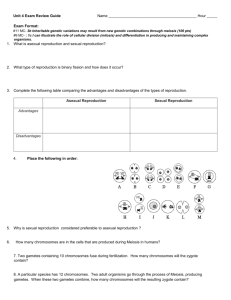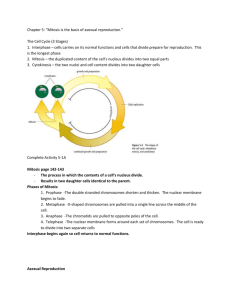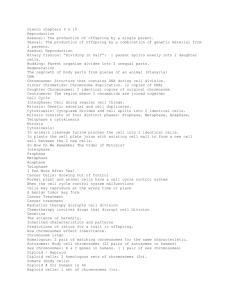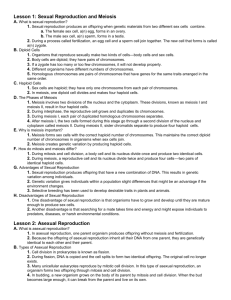DNA & RNA - Alvin ISD
advertisement
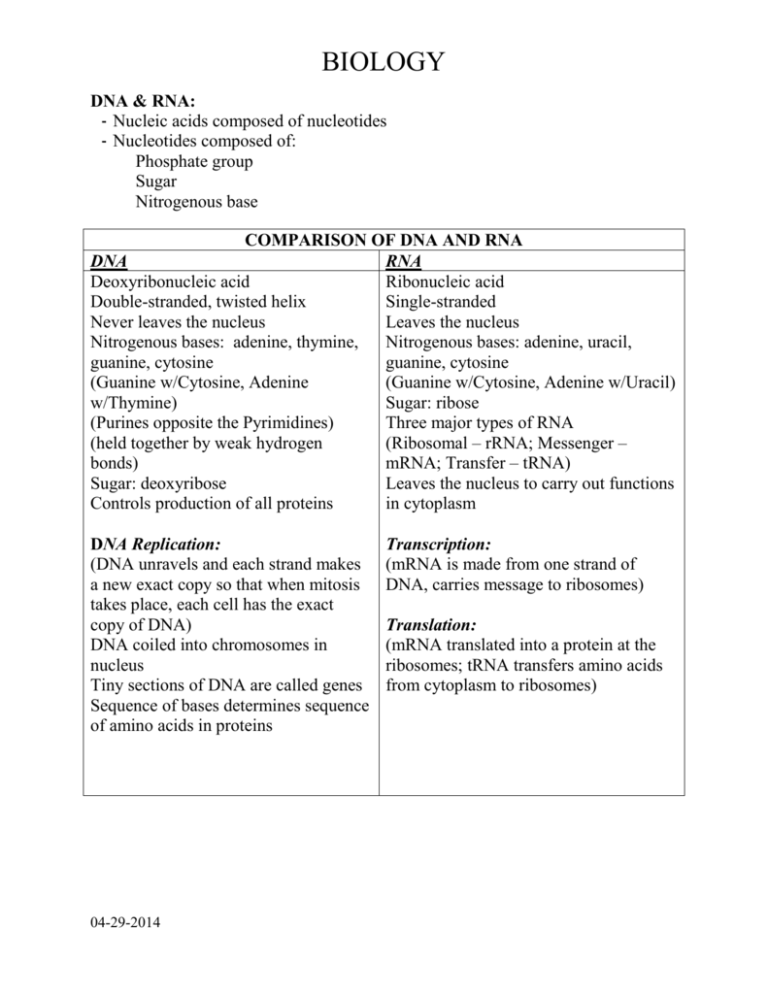
BIOLOGY DNA & RNA: - Nucleic acids composed of nucleotides - Nucleotides composed of: Phosphate group Sugar Nitrogenous base COMPARISON OF DNA AND RNA DNA RNA Deoxyribonucleic acid Ribonucleic acid Double-stranded, twisted helix Single-stranded Never leaves the nucleus Leaves the nucleus Nitrogenous bases: adenine, thymine, Nitrogenous bases: adenine, uracil, guanine, cytosine guanine, cytosine (Guanine w/Cytosine, Adenine (Guanine w/Cytosine, Adenine w/Uracil) w/Thymine) Sugar: ribose (Purines opposite the Pyrimidines) Three major types of RNA (held together by weak hydrogen (Ribosomal – rRNA; Messenger – bonds) mRNA; Transfer – tRNA) Sugar: deoxyribose Leaves the nucleus to carry out functions Controls production of all proteins in cytoplasm DNA Replication: (DNA unravels and each strand makes a new exact copy so that when mitosis takes place, each cell has the exact copy of DNA) DNA coiled into chromosomes in nucleus Tiny sections of DNA are called genes Sequence of bases determines sequence of amino acids in proteins 04-29-2014 Transcription: (mRNA is made from one strand of DNA, carries message to ribosomes) Translation: (mRNA translated into a protein at the ribosomes; tRNA transfers amino acids from cytoplasm to ribosomes) BIOLOGY Asexual and Sexual Reproduction: Asexual Reproduction – a single parent produces one or more identical offspring by dividing into two cells - mitosis (protists, arthropods, bacteria by binary fission, fungi, plants); produces large numbers of offspring - Offspring are clones of parents (genetically identical) - Common in unicellular organisms, good for stable environments - Budding, binary fission, conjugation - Quick process (low energy requirement) – produces high number of offspring Sexual Reproduction – pattern of reproduction that involves the production and fusion of haploid sex cells; haploid sperm from father fertilizes haploid egg from mother to make a diploid zygote that develops into a multicellular organism through mitosis - Results in genetic variation (diversity) - common in multicellular organisms (external or internal fertilization); good for changing environments - slow process (high energy requirement) – produces low number of offspring - meiosis = formation of sex cells (gametes) 04-29-2014 BIOLOGY Asexual and Sexual Reproduction: Asexual Reproduction – a single parent produces one or more identical offspring by dividing into two cells - mitosis (protists, arthropods, bacteria by binary fission, fungi, plants); produces large numbers of offspring - offspring are clones of parents (genetically identical) - common in unicellular organisms, good for stable environments - budding, binary fission, conjugation - quick process (low energy requirement) – produces high number of offspring Sexual Reproduction – pattern of reproduction that involves the production and fusion of haploid sex cells; haploid sperm from father fertilizes haploid egg from mother to make a diploid zygote that develops into a multicellular organism through mitosis - results in genetic variation (diversity) - common in multicellular organisms (external or internal fertilization); good for changing environments - slow process (high energy requirement) – produces low number of offspring - meiosis = formation of sex cells (gametes) CELL DIVISION: - process of copying and dividing the entire cell - the cell grows, prepares for division, and then divides to form new daughter cells - allows unicellular organisms to duplicate in a process called asexual reproduction - allows multicellular organisms to grow, develop from a single cell into a multicellular organism, make other cells to repair and replace worn out cells - three types: binary fission (bacteria and fungi), mitosis, and meiosis 04-29-2014 BIOLOGY MITOSIS Cell cycle consists of interphase, mitosis, and cytokinesis Interphase – longest part of cell cycle Growth, metabolism, and preparation for division occurs Duplicates chromosomes (DNA Replication) Mitosis – division of nucleus of the cell - Prophase - duplicated chromosomes and spindle fibers appear - Metaphase – duplicated chromosomes line up randomly in center of cell between spindle fibers - Anaphase – duplicated chromosomes pulled to opposite ends of cell - Telophase – nuclear membrane forms around chromosomes at each end of cell; spindle fibers disappear; chromosomes disperse Cytokinesis – division of plasma membrane; two daughter cells result with exact genetic information (in plant cells a “cell plate” forms along the center of the cell and cuts the cell in half; cell plate forms new cell walls once the plasma membrane divides) RESULTS: Two daughter cells (body cells) Same number of chromosomes as original cell (humans = 46) Cells are diploid (human diploid # = 46 or 23 homologous pairs) MEIOSIS Consists of two cell divisions, but only one chromosome replication (sometimes called reduction division) Each cell division consists of prophase, metaphase, anaphase, and telophase Occurs only in sex cells – to produce more sex cells (gametes) First Meiosis Division Produces cells containing ½ # of double stranded chromosomes Second Meiosis Division Results in formation of four cells Each cell w/ ½ # of single-stranded chromosomes (haploid cells) -----------------------------------------------------------------------------------Sperm Each primary sperm cell develops into four haploid cells of equal size. As cells mature, the cells lose most of their cytoplasm and develop a long whip-like tail for movement. 04-29-2014 BIOLOGY Egg Each primary egg cell develops into one large haploid cell and three smaller haploid cells called polar bodies. The first meiosis division produces one large cell and one polar body. The second meiosis causes the large cell to produce one egg cell and a polar body; the original smaller polar body divides into two polar bodies. The polar bodies eventually disintegrate. The final egg cell is provided with the larger supply of stored nutrients RESULTS: Four daughter cells (sex cells) ½ # of chromosomes (haploid) with genetic variation (n = 23) Sex cells combine during sexual reproduction to produce a diploid individual GENETICS: – branch of biology that deals with heredity – Gregor Mendel experimented with sweet pea plants in 1800s – Trait – characteristic an individual receives from its parents – Gene – carries instructions responsible for expression of traits; a pair of inherited genes controls a trait; one member of the pair comes from each parent; often called alleles – Homozygous – two alleles of a pair are identical (BB or bb) – Heterozygous – two alleles of a pair are different (Bb); often called “hybrid” – Dominant – controlling allele; designated with a capital letter – Recessive – hidden allele; designated with lower-case letters – Genotype – genetic makeup of an organism (represented by the letters) – Phenotype – physical appearance of an organism (description of the letters) – Monohybrid – cross involving one trait – Dihybrid – cross involving two traits – Punnett Square – graphic organizer used to show the probable results of a genetic cross – Pedigree – graphic organizer to map genetic traits between generations – Karyotype – chart of metaphase chromosome pairs to study chromosome number / diseases – Test Cross – mating of an individual of unknown genotype with an individual of known genotype; can help to determine the unknown genotype of the parent Reward time evolution of skin http://www.youtubedocumentaries.com/documentary.cfm?name=Evolution_of_Skin#.U11oNKL JXoJ 04-29-2014




